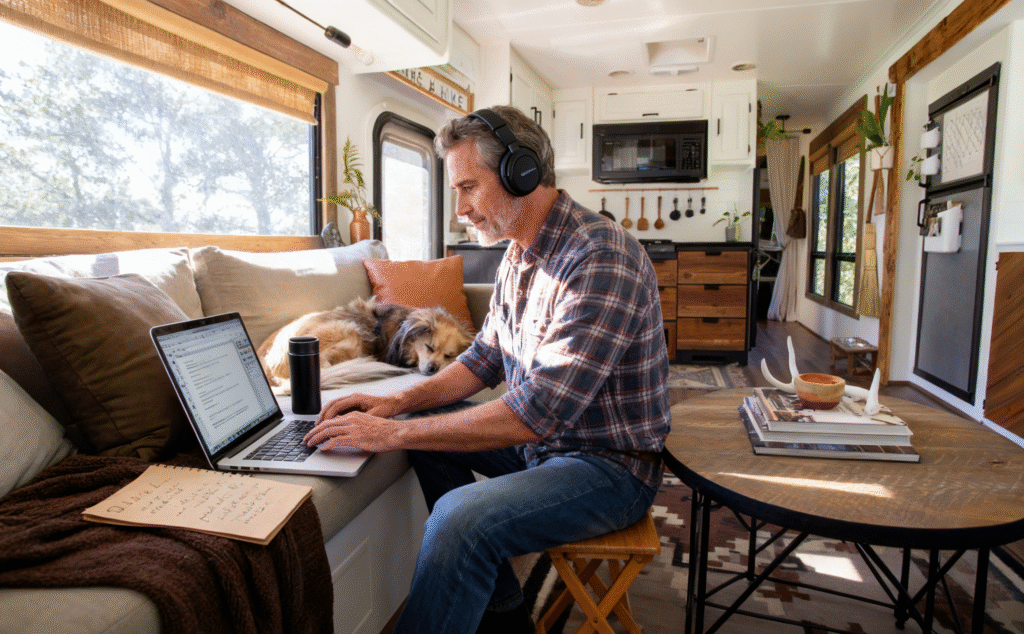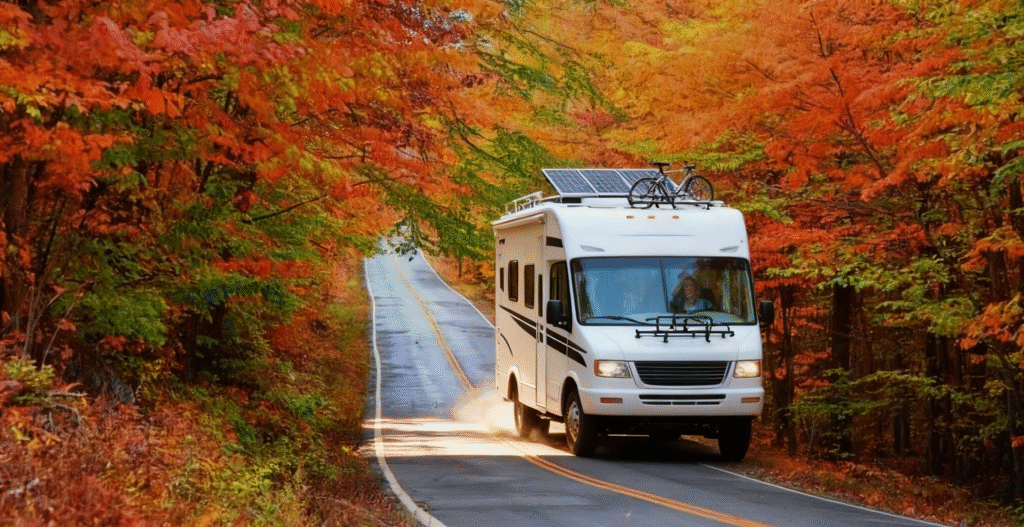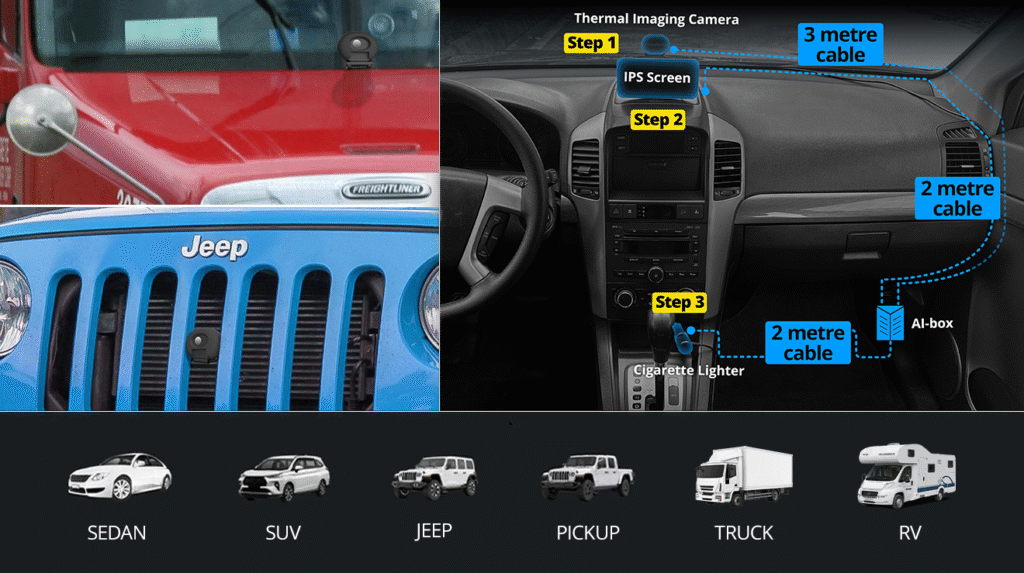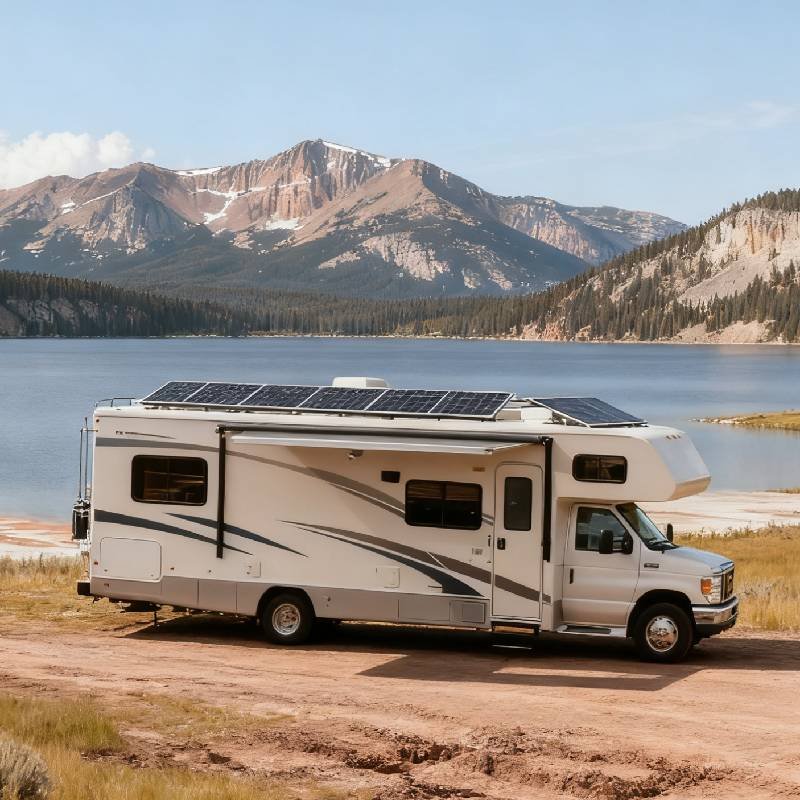Full-Time RV Living: The Unspoken Struggle 1.2 Million Families Face
Explore why Full-Time RV Living is booming in the US. We cover trends, challenges like safety & power, and smart solutions like thermal imaging cameras for your RV.
Full-Time RV Living is a major trend across the United States. More people are choosing to live in recreational vehicles. They turn them into mobile homes. This lifestyle offers freedom and reduces financial pressure. But it also brings challenges like road safety and power management.
The Robofinity InsightDrive thermal imaging system is a tech solution made for the Full-Time RV Living community. It helps protect drivers and passengers. It makes RV adventures safer and more enjoyable.

1. Why Are More People Choosing Full-Time RV Living?
1.1. Financial Factors: An Affordable Housing Alternative
The U.S. housing market is getting more expensive. The median home price reached $415,000 in 2023. That’s up 3.2% from 2022. Rent prices also rose by over 5% nationwide. In states like California and Oregon, rents increased by 7.1%. For many, rent now takes over 30% of their income. That’s above the recommended 25%.
Full-Time RV Living is more affordable. A new Class B RV costs between $120,000 and $180,000. That’s only one-third to half the median home price. A used Class C RV averages $50,000 to $100,000. There’s no need for a long mortgage.
Renting an RV is also cost-effective. Monthly rentals are between $1,500 and $3,000. That’s lower than rent in California or Manhattan. This flexibility helps people manage budgets. It supports the Full-Time RV Living lifestyle.

1.2. Pursuit of Freedom and Adventure
Minimalism and digital nomad lifestyles are growing. Full-Time RV Living fits these trends well. A 2023 report showed the U.S. has 17.3 million digital nomads. Thirty-eight percent live in RVs. They can work and explore nature.
Minimalism means living with less. RVs have limited space—usually 150–300 square feet. This helps people keep only what they need.
For digital nomads, an RV is a mobile office. They can work from national parks or lakesides. After work, they can hike or fish immediately.
This lifestyle allows free travel. See wildflowers in Arizona in spring. Escape heat in Montana in summer. Enjoy fall colors in Vermont. Stay warm in Florida in winter. Every day is a new adventure. Full-Time RV Living becomes an irresistible choice.

1.3. Social and Cultural Shifts After the Pandemic
The RVIA’s 2024 report shows 1.2 million households lived full-time in RVs in 2023. That’s a 42% increase since 2020. The pandemic changed how people think about life. A 2021 survey found 62% of Americans wanted more flexibility. They wanted less dependence on one location.
RVs offer self-contained living. They have kitchens and bathrooms. People can avoid public spaces. During the pandemic, many moved from cities to rural areas in RVs.
Online communities provide great support. RVillage has over 1 million users. Seventy percent are full-time RVers. Users share over 5,000 posts daily about parking, repairs, and routes.
For example, one user had a water tank leak in the Arizona desert. Another RVer arrived within an hour to help. Another planned a trip to see the Northern Lights. Experienced travelers shared tips on staying warm and where to park. This support makes Full-Time RV Living easier and more appealing.
1.4. Environmental Sustainability: A Greener Way to Live
People are more environmentally conscious now. Full-Time RV Living has a smaller carbon footprint. The average full-time RVer produces 6.8 tons of CO₂ per year. That’s only 47% of what the average household produces.
Eighty-five percent of new RVs have solar power systems. For example, Winnebago’s Solis model has a 200W solar panel and a 200Ah lithium battery. On sunny days, this can cover 80% of daily electricity needs.
Sixty percent of full-time RVers use rainwater collection systems. These can save up to 150 gallons of tap water each month.
Social media influencers share tips on zero-waste RV living. Kaylee Christiansen (@RVZeroWaste) has over 200,000 followers. She inspires more people to choose eco-friendly Full-Time RV Living.
2. Common Challenges of Full-Time RV Living
2.1. Road Safety: Risks in Low Visibility
Driving a large RV is challenging in bad weather. The NHTSA reports about 2 million accidents yearly due to poor visibility. RV accidents account for 12% of these. That’s higher than passenger cars.
RVs are bigger. They take 30% longer to stop. This makes accidents harder to avoid.
Wildlife collisions are another concern. There were over 150,000 wildlife-vehicle accidents in western states in 2023. Seventy percent happened at night. Animals like deer, elk, and bears often cross roads.
In 2022, an RV hit an elk in Wyoming. The RV was badly damaged. The driver broke an arm.
Many full-time RVers drive long distances at night. For example, going from Arches National Park to Sun Valley is a 400-mile, 6-hour drive. Low visibility makes these trips riskier.

2.2. Power Management: Limited Energy Supply
RVs rely on batteries. Lead-acid batteries hold 100–200Ah. Lithium ones hold 200–400Ah. Without external power, it’s hard to meet daily needs.
Common energy concerns include:
- In summer, air conditioning (1000W) can drain a 200Ah battery in 4–5 hours.
- In winter, an electric blanket (50W) and fridge (50W) use about 2.4kWh per day. A 300Ah battery lasts only 3 days.
- Remote work uses laptops (60W), phones (10W), and routers (15W). Eight hours of work uses 0.68kWh. That’s 35% of a 200Ah battery.
Poor energy management leads to spoiled food or no lights. In 2023, 32% of RVillage users shared stories of running out of power. One user in the Arizona desert waited 24 hours for help after their battery died.
2.3. Internet and Connectivity Issues
Seventy percent of full-time RVers rely on remote work. But many RV destinations have poor signal.
Rural areas have only 68% 4G coverage. They have under 20% 5G. Cities have 98% 4G and 75% 5G.
This affects work. In 2023, a remote worker in Badlands National Park had five video call drops in one hour. They lost their monthly bonus.
In emergencies, poor signal can be dangerous. In 2022, an RV got stuck in mud in New Mexico. The driver walked 3 miles to find signal and call 911.
Even with mobile hotspots, download speeds can be below 1Mbps in weak areas. This makes it hard to load web pages or send emails.
2.4. Limited Space and Storage
RVs are small. Class B RVs have 150–200 sq ft inside. Class C RVs have 250–300 sq ft. That’s only ¼ to ⅓ of an average apartment.
Common challenges include:
- Clothing storage: RV closets are half the size of home closets. Many store off-season clothes under beds.
- Kitchen storage: People keep only one frying pan, one pot, and three bowls. They use small containers for spices.
- Items shifting during travel: Unsecured things can break or spill. One user shared how a flour bag tipped over during a drive. It made a huge mess.
To save space, RVers use wall-mounted racks, under-bed drawers, and foldable tables. These can increase storage by 30–50%.
2.5. Mental Health and Loneliness
Moving often can be exciting but isolating. It’s hard to build long-term friendships on the road.
Some people feel anxious in new environments. Without friends or family nearby, it’s easy to feel lonely.
Online communities help, but they can’t replace in-person support. Mental health is a real concern for those embracing Full-Time RV Living.
3. How Technology Solves RV Lifestyle Challenges
3.1. Robofinity InsightDrive: Your Safety Co-Pilot for Full-Time RV Living
Driving safety is a top concern. The Robofinity InsightDrive thermal imaging system is made for the RV lifestyle.
It uses advanced thermal imaging. It detects people, cars, and animals in total darkness, rain, fog, or snow. It needs no external light. For night drivers, its 656-foot warning range is a game-changer. It gives crucial extra seconds to react.
Its AI-powered alert system is 95% accurate. It uses color-coded warnings for dangers up to 656 feet away. This gives drivers more time to react.
According to user reviews, the device is also:
- Waterproof (IP67 rated). It works in all weather.
- Low-power (≤5W). It suits Full-Time RV Living where battery life is precious. It won’t strain your electrical system.
- Easy to install in just 5 minutes with the 12V cigarette lighter plug.
- Compatible with most RVs, including Class A, B, C, and travel trailers.
It works with a mobile app for easy updates and settings. This ensures your safety system always improves.
3.2. Other Helpful Solutions for Full-Time RV Living
- Solar panels + lithium batteries: Great for off-grid power.
- Satellite internet (e.g., Starlink): Provides reliable internet in remote areas.
- Foldable and multi-use furniture: Saves space and adds functionality.
4. Frequently Asked Questions (FAQ)
Q1: Is full-time RV living legal in the U.S.?
Yes, but rules vary by state. Some states restrict overnight parking. Check local laws. Use a mail forwarding service like Escapees RV Club for a legal address.
Q2: What is the biggest safety risk in RV life?
Poor visibility at night or in bad weather. Over 2 million accidents yearly are due to low visibility. A thermal vision system like Robofinity InsightDrive reduces this risk.
Q3: Does Robofinity InsightDrive work with all RVs?
Yes. It works with any RV that has a 12V power outlet. This includes Class A, B, C, and trailers.
Q4: How can I get good internet in my RV?
Use a mobile hotspot (Verizon/AT&T), a signal booster, and satellite internet like Starlink.

5. Conclusion
Full-Time RV Living is more than a trend. It offers freedom, adventure, and simplicity. But it also brings challenges like safety, power, internet, and space.
Technology solves these problems. The Robofinity InsightDrive helps drivers see clearly and stay safe. It’s a critical advantage for the Full-Time RV Living community. Solar power, satellite internet, and smart storage make life easier and more comfortable.
With the right tools, full-time RV living is safer and more enjoyable. You can truly take your home anywhere and enjoy every journey.

